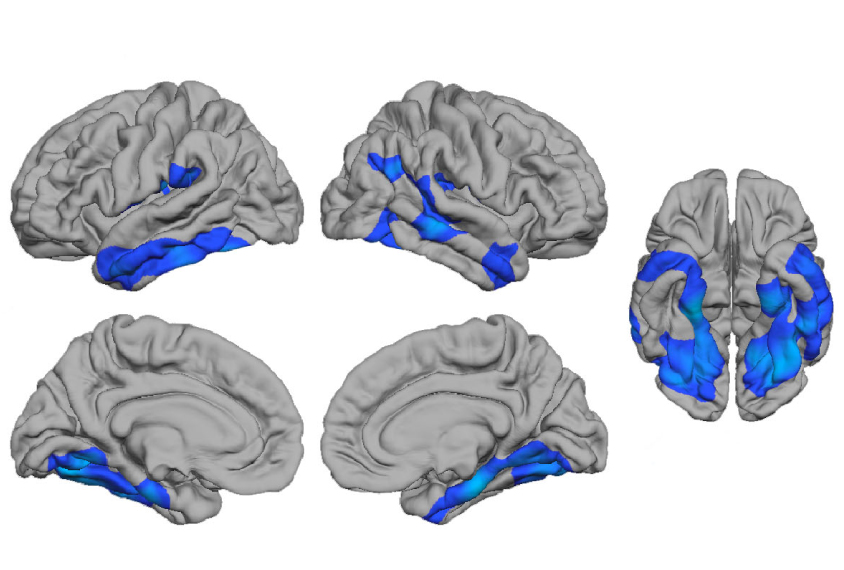
Brains of women with autism may sport male features
The brains of some women with autism more closely resemble those of typical men than those of typical women.
Editor’s Note
The finding described below — that the brains from autistic women resemble those of typical men — was retracted 27 March 2019. It resulted from a statistical error, the authors say.
The brains of some women with autism more closely resemble those of typical men than those of typical women, according to a study published 8 February in JAMA Psychiatry1.
Using brain imaging, the researchers mapped the brains of typical men and women along a spectrum. Nearly 80 percent of the brains of women with autism fall at the male end of this spectrum, they found.
“We’re not saying that women with autism have male brains, but if you look at some aspects of brain anatomy, they have regions and features that look more like a male than a female brain,” says lead researcher Christine Ecker, professor of child and adolescent psychiatry at Goethe University in Frankfurt, Germany.
Autism is more prevalent in men than in women, with the ratio of those diagnosed at five to one. One theory holds that this is because women are somehow protected from autism. The new findings mesh with this theory. However, the brain differences in women with autism may also be a consequence of the condition.
The study also jibes with the ‘extreme male brain’ theory of autism. This theory posits that autism features are an extension of stereotypically male traits, such as the tendency to look at things systematically rather than empathetically.
The results diverge from that theory in one important respect, however: Men who have especially ‘male’ brains, according to the brain imaging findings, do not have an increased incidence of autism.
Machine learning:
Ecker and her team used magnetic resonance imaging to measure the thickness of the cerebral cortex, which coordinates higher-order cognitive functions. Previous studies have suggested that the cortex is thinner in people with autism than in people without the condition.
The researchers scanned the brains of 51 men and 47 women without autism, measuring the thickness of roughly 320,000 locations of the cortex. They then used a computer algorithm to ferret out a combination of regions for which differences in cortical thickness are most likely to differentiate men from women.
The algorithm, which involves machine learning, found a pattern of thickness that typifies a female brain, and assigned it a score of 0; it assigned a score of 1 to a pattern that is most predictive of a male brain. The algorithm then scored the cortical thickness patterns of each brain in the study relative to these idealized ones.
The researchers found that the majority of typical women score between 0 and 0.5 on this scale, and the majority of typical men between 0.5 and 1. Many men and women have scores that fall between 0.4 to 0.6, however, suggesting that all brains fall along a spectrum ranging from especially male to especially female, Ecker says.
Ranking brains along a scale rather than placing them into a male or female category is “an advance in the right direction,” says Daphna Joel, professor of psychology and neuroscience at Tel Aviv University in Israel. But referring to a ‘male’ or ‘female’ brain is still problematic, she says.
Risk shift:
The researchers then used the same measure to categorize the brains of 49 men and 49 women with autism. They found that 39 of the women fall into the male range of the scale.
Women in the study who scored in the male range are three times as likely as those in the female range to have autism, the researchers found. By contrast, men who score in the female range are 1.2 times less likely to have autism than those who score in the male range.
However, men who score near 1 have a similar incidence of autism to those scoring closer to 0.5. This suggests that having an especially ‘male’ brain does not increase the risk of autism, Ecker says.
The study’s size is one of its biggest strengths, says Donna Werling, a postdoctoral associate in Stephan Sanders’ lab at the University of California, San Francisco, who was not involved in the study. “That degree of matching and recruitment to fill all four of those categories is something that I wish more researchers would do.”
Another strength of the study is that the researchers generated the scores based on typical participants and then applied them to people with autism. Studies often use the same participants to make and validate their prediction, which is problematic, says Kevin Pelphrey, director of the Autism and Neurodevelopmental Disorders Institute at George Washington University in Washington, D.C., who was not involved in the study.
“It’s a really cool application of [this approach], just a really nice elegant set of math,” he says.
It is unclear whether the atypical cortical thickness seen in women with autism contributes to or arises from their autism. It is also not known whether cortical thickness tracks with sex-related cognitive or behavioral features, Ecker says.
The researchers plan to repeat the study in younger participants. They are especially interested in how the brain changes during adolescence, as puberty hormones are known to affect many brain regions.
References:
- Ecker C. et al. JAMA Psychiatry Epub ahead of print (2017) PubMed
Recommended reading

New organoid atlas unveils four neurodevelopmental signatures

Glutamate receptors, mRNA transcripts and SYNGAP1; and more

Among brain changes studied in autism, spotlight shifts to subcortex
Explore more from The Transmitter

Psychedelics research in rodents has a behavior problem
Can neuroscientists decode memories solely from a map of synaptic connections?
